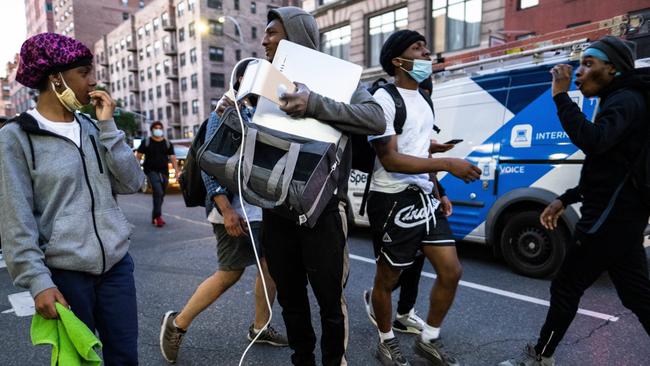US protests: Opportunists behind most of the looting
Much of the US destruction and theft appears to have been perpetrated by people who saw unrest as a chance to commit crimes.

As largely peaceful protests have erupted across the US, they have frequently been followed by looting. Criminals have stolen from high-end clothing stores on New York’s Fifth Avenue, retail restaurants in Minneapolis, and an Amazon van in Santa Monica, California.
Much of the destruction and theft appears to have been perpetrated by people who saw civil unrest as an opportunity to commit crimes with a low risk of being caught, according to witnesses, business owners and law enforcement agents.
“I think they were gang members,” New York mayor Bill de Blasio said on Wednesday (AEST).
“I don’t think they were organised by anything other than their own gang.”
Law enforcement officials said they had so far seen a range of motivations among those engaging in violence, from self-described anarchists to anti-government protesters from both sides of the political spectrum to criminal opportunists using the chaos to steal merchandise.
Some state and federal officials, including Attorney-General William Barr, have tried to blame violence and looting on outside agitators, but many of those arrested have been local residents, according to official records.
The sheriff’s office in Hennepin County, which includes Minneapolis, said of the 544 people cited and released by police, or charged with an infraction for any crimes related to the protests, between May 25 and Tuesday afternoon, 82 per cent were from Minnesota.
In New York City, more than 700 people were arrested on Monday night and Tuesday morning in incidents related to the protests, police said, although they didn’t break down how many were specifically for looting or theft.
The number of people demonstrating, often in the thousands in each city, has far outnumbered those looting, but protest organisers said they worried that their message about the need to end police brutality was being obscured by criminal activities, whether by people involved in protests or those who took advantage of the situation.
“I am very concerned that they feel like they are doing this on our behalf, and we didn’t ask for it,” said Tay Anderson, a 21-year-old African-American Denver school board member, who has been helping to lead the protests in that city.
“I also think there are just people who are just showing up to destroy shit because there is an opportunity to do so.” Some protesters said they feared looters were taking public attention away from the goals that demonstrators were trying to achieve.
“I understand the frustration, but it’s heartbreaking,” said Debra Scharwath, a 62-year-old marching in downtown Los Angeles on Tuesday. “I can understand, but can’t be supportive of it.”
At Kovac’s Care Pharmacy in the Los Angeles neighbourhood of Van Nuys, looters came 10 at a time on Monday, in multiple waves, said manager Eva Bandikian. She told her employees to go home at 2.30pm, when delivery drivers told her the situation around the corner looked bad.
An hour later, soon after she fled, she got a call from the alarm company saying the shop had been breached.
“They were random people, just coming in and grabbing anything they saw,” Ms Bandikian said of the thieves.
Late on Tuesday morning, Kovac’s was boarded up, with a sign taped to a piece of wood that read, “We support #BLM Do not loot”, in a reference to the Black Lives Matter movement.
In Sacramento, Clint Hopkins saw his pharmacy looted on Sunday night and into Monday morning. When the security alarm went off, he arrived armed with a gun to scare looters away, but they ignored him.
He said police didn’t respond to calls for help. Eventually, he decided “I don’t want to kill someone” and left, he recalled thinking.
Dr Hopkins, a pharmacist, has reviewed video footage and estimated hundreds of people came in and took everything from blood-pressure medications to sweets and coins from the register. “It wasn’t organised,” he said.
Asked why he believed the looters hit his pharmacy, as well as others in the area, he said: “They knew the police were busy.”
In other cities, such as New York, looters appeared to be more organised.
Dan Biederman, president of the 34th St Partnership, a Manhattan business group, estimates 20 stores were burgled by groups of looters working together on Monday night alone. He estimated damage in the area was in the hundreds of millions of dollars.
Mr Biederman said looters came by to scout the area during the day on bicycles and then returned later on foot among protesters. Once the protesters left at night, gangs hit specific stores.
“The looting is not chaos,” he said. “It’s extremely well planned.”
The Wall Street Journal



To join the conversation, please log in. Don't have an account? Register
Join the conversation, you are commenting as Logout